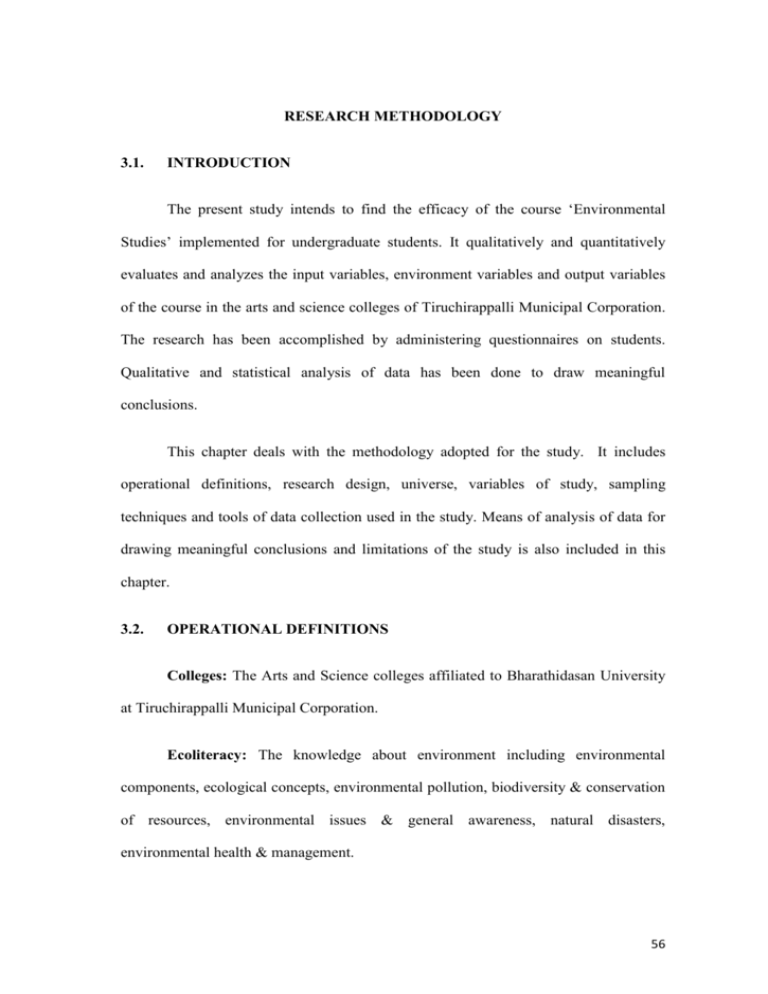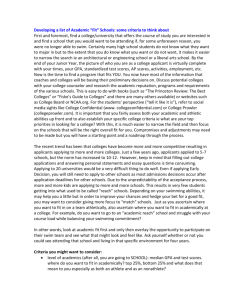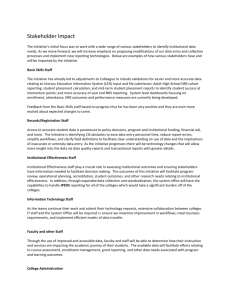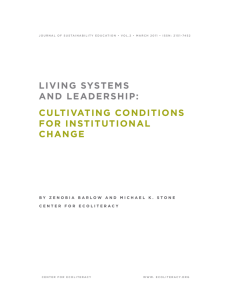03 EE Chapter III 5
advertisement

RESEARCH METHODOLOGY 3.1. INTRODUCTION The present study intends to find the efficacy of the course ‘Environmental Studies’ implemented for undergraduate students. It qualitatively and quantitatively evaluates and analyzes the input variables, environment variables and output variables of the course in the arts and science colleges of Tiruchirappalli Municipal Corporation. The research has been accomplished by administering questionnaires on students. Qualitative and statistical analysis of data has been done to draw meaningful conclusions. This chapter deals with the methodology adopted for the study. It includes operational definitions, research design, universe, variables of study, sampling techniques and tools of data collection used in the study. Means of analysis of data for drawing meaningful conclusions and limitations of the study is also included in this chapter. 3.2. OPERATIONAL DEFINITIONS Colleges: The Arts and Science colleges affiliated to Bharathidasan University at Tiruchirappalli Municipal Corporation. Ecoliteracy: The knowledge about environment including environmental components, ecological concepts, environmental pollution, biodiversity & conservation of resources, environmental issues & general awareness, natural disasters, environmental health & management. 56 Environmental Studies Course: The course introduced by UGC since 2004 to all undergraduate studies in India. Input Variables: The variables such as colleges, stream of study, gender and residence that influence the Environmental Studies course. Environment Variables: The variables such as level of integration, teaching practices, course content and assessments that influence the Environmental Studies course. Output Variable : The variable ecoliteracy including sub dimensions 3.3. 1. Environmental components and ecological concepts 2. Environmental pollution 3. Biodiversity & conservation of resources 4. Environmental issues & general awareness and 5. Natural disasters, environmental health & management. RESEARCH DESIGN According to C.R.Kothari (2004) descriptive research is description of the state of affairs as it exists and in-depth approaches to find the association of the variables is diagnostic research. The current study describes the state of environment education program implemented at colleges and analyzes the association of ecoliteracy with independent variables. Hence the research is Descriptive cum Diagnostic Research Design. This is accomplished by qualitative analysis of environment variables and quantitative analysis of input and output variables. Hence Qualitative and Quantitative research approaches have been adopted. Quantitative research is based on the 57 measurement of quantity or amount. It is applicable to phenomena that can be expressed in terms of quantity. Qualitative research, on the other hand, is concerned with qualitative phenomenon, i.e., phenomena relating to or involving quality or kind that investigates the reasons C.R.Kothari (2004). A comprehensive analysis of literature shows more of quantitative research rather than qualitative studies. There are supporters and defenders of both methods. However, Sogunro (2001) emphasizes “the usage of numbers and descriptions, which anchor both quantitative and qualitative research paradigms, are mutually complementary, and the strengths of both can produce a research synergy in which whole collective benefits are greater than obtained from either approach taken alone”. In this regard the present study adopted the qualitative as well as quantitative research methods to analyze efficacy of education program. A thorough education research program should include analysis of three variables: input (the characters of the subject of study), environment (the conditions in which the program/activity occur) and output (the effects of the program) named as the ‘I-E-O model’ (Austin, 1991 in Oksana, 2003). Therefore the present study is intended to find the efficacy of education program by analyzing the factors influencing ecoliteracy (input variable), the mode of implementation of environmental education (environment variable) and the ecoliteracy level (output variables) of the environment education program for undergraduate students. The universe of the study is I year undergraduate students of Arts and Science colleges at Tiruchirappalli Municipal Corporation. The descriptive cum diagnostic study was accomplished by administering questionnaires and analyzed quantitatively 58 and qualitatively. Data were collected from an Environmental Science teacher selected randomly from the educational institutes to collect information on mode of implementation and I year undergraduate students to assess the mode of implementation, ecoliteracy level as well as factors influencing ecoliteracy level. The environment variable was analyzed by content analysis method as well as data obtained from questionnaires. Statistical tests such as mean, median, Student ‘t’-test, Paired sample T Test, One way analysis of variance, Karl Pearson’s Co-efficient of correlation and Inter-correlation matrix were applied to interpret the data to draw meaningful inferences. 3.3.1. UNIVERSE The universe of the study is Arts and Science colleges at Tiruchirappalli Municipal Corporation which are affiliated to Bharathidasan University. Bharathidasan University (BDU) established in1982 is located at 10°40′29″N 78°44′39″E in the city of Tiruchirapalli, Tamil Nadu state, India. It is a recognized university, supported by the University Grants Commission of India. The university in all has 14 Schools and 27 departments and 8 centres. It has affiliated colleges in districts of the state, including Nagapattinam, Perambalur, Pudukkottai, Thanjavur, Tiruvarur other than Tiruchirapalli. The affiliating jurisdiction is over 138 Arts & Science/Fine Arts/Education Colleges and 18 approved institutions. There are 14 Arts and Science colleges which come under Tiruchirappalli Municipal Corporation. These affiliated colleges belong to aided (government funded) or self financing category and are either autonomous or non-autonomous. Seven colleges are autonomous while the remaining seven are non autonomous. There are 9 aided colleges and 7 self financing colleges; 2 59 government and 12 private colleges. During the academic year 2010-2011 about 10,500 students had enrolled for their first year degree course in all these arts and science colleges. Hence, for the present study, the universe is finite. The names of the colleges and the numbers of respondents are presented in Table 3.1. TABLE 3.1 - DISTRIBUTION OF RESPONDENTS BY COLLEGE S. No. College No. of Respondents (n.420) 1 National College 30 2 Kurinji Arts & Science College 30 3 Srimathi Indira Gandhi College 30 4 St. Joseph College 30 5 Seethalakshmi Ramaswamy College 30 6 Cauvery College 30 7 Holy Cross College 30 8 Christu Raj College 30 9 Srimadh Andavar College 30 10 Jamal Mohamed College 30 11 Urumu Dhanalakshmi College 30 12 Government Arts College 30 13 Bishop Heber College 30 14 EVR Periyar College 30 60 3.3.2. SAMPLING TECHNIQUE To assess the mode of implementation (environment variable) sampling was done by randomly selecting a faculty who teaches Environmental Studies by lottery method and thirty first year undergraduate students. To assess the ecoliteracy level (output variables) and the factors influencing ecoliteracy (input variables) the respondents were thirty first year undergraduate students from each college. Out of 10,500 students who are spread across 14 arts and science colleges, the researcher selected 420 students using Stratified Disproportionate Random Sampling Method considering each college as one stratum. Irrespective of the total number of students in the college, thirty students from the first year undergraduate studies were chosen using lottery method. The details are as follows. 3.3.3. PILOT STUDY & PRE TEST With the objective of gaining practical perspective and to assess the feasibility of the present study, the researcher went for pilot visit. The discussions with the different faculty members of the affiliated colleges, subject and field experts helped the researcher to understand the need and importance of the study based on which the researcher was able to finalize the methodology and design of the present research. A self prepared questionnaire was used as the tool for collecting data for the present study. Before finalizing the tools of data collection to be used, discussions were held with teachers, students and environmentalists to decide 61 on the relevant questions. Review of the existing literatures on Environmental Education as well facilitated to finalize the relevant tools of data collection. A pilot study was carried out and pre test was done with 30 students by administering the self prepared questionnaire to evaluate the ecoliteracy. With further discussions and guidance from experts in the field of environmental sciences certain corrections were carried over and the improvised questionnaire was used for the study. 3.3.4. DATA COLLECTION The instruments and procedures used are essential to the evaluation of any educational program to assess that program's efficacy. Standardized tests with validity and reliability, fulfilling another requirement of evaluation usually are administered for the purpose. However, recent research on student achievement has focused on problems associated with over-reliance on standardized tests. Alternative approaches to assess education programs that address many of the problems associated with standardized tests have been suggested (Rogers, 1989). On that basis questionnaires were prepared and validity and reliability characteristics established after administering to the sample. 3.3.4.1. INSTRUMENTS A self prepared questionnaire was used as the tool for collecting data for the present study. The socio-demographic studies can be grouped around six basic issues (Dietz et al., 1998) that refer to variables such as age and cohort; education, political ideology and place of residence; race and ethnic group; income, social class, occupation and industrial sector; gender; and religion. 62 Hence the first part of the schedule comprised of questions pertaining to personal information of the respondents. On this basis for the current study the input variables as college of study, stream of education, gender and place of residence have been taken into consideration for investigation. The second part comprised of questions pertaining to environment variables including teaching, evaluation, students’ and administrators’ attitude that depict the mode of implementation. The third part comprised of questions to evaluate the ecoliteracy of the students. (Appendix II : The questionnaire distributed to faculty representative (Appendix III: The questionnaire distributed to students). 3.3.4.1.1. INDEX ON ECOLITERACY In order the measure the knowledge on ecoliteracy and its sub dimensions, the researcher constructed an Index on Ecoliteracy. Face validity and content validity was established with the experts in the field along with the research supervisor. The final part through which ecoliteracy was evaluated based on five sub dimensions on environment including 1. Environmental components and ecological concepts 2. Environmental pollution 3. Biodiversity & conservation of resources 4. Environmental issues &general awareness 5. Natural disasters, environmental health & management Each sub dimension had ten questions each with four options to choose. The correct option was credited with one score and the wrong ones and unanswered ones were assigned zero score. The data collected by administering 63 questionnaire were analyzed to make estimates of the precision. Alpha reliability was established and it was found to be 0.6807. The mode of implementation of the course was analyzed qualitatively in terms of level of integration, teaching practices, assessments and course content and quantitatively evaluated for the influence of non formal environmental education and impact of asking questions in vernacular language Tamil (Appendix IV : The questionnaire distributed to students in vernacular language Tamil) over the second language (English). 3.3.4.2. DATA COLLECTION PROCESS Data collection was carried during March through May 2012 after the first year undergraduate students had taken up the Environmental Studies course and later in June and July 2012 from those who did not take the course. Questionnaires were administered to one representative of the educational institutes and 30 students of each institute to collect information on mode of implementation. The sample (representative) was chosen on random sampling basis. The self prepared questionnaire was used as the tool for collecting data for evaluating the ecoliteracy. The dependent variables were classified based on the syllabus framed by the UGC and followed by all the colleges. Questionnaires were administered to 420 first year undergraduate students in the Arts and Science colleges at Tiruchirappalli Municipal Corporation on disproportionate stratified random sampling basis. The first part of the questionnaire comprised of independent variables focusing on personal data focusing on sociodemographic data. The second part consisted of questions on 64 environment variables. The third part focused on output variables classified on five sub dimensions of ecoliteracy. 3.3.5. ANALYSIS OF DATA The data collected were carefully processed, analyzed qualitatively and quantitatively. The environment variables were analyzed qualitatively and substantiated with quantitative data. The course content was analyzed by content analysis method. The input variables and output variables were analyzed by applying the statistical tests such as mean, Student‘t’-test, Paired sample T Test, One way analysis of variance, Karl Pearson’s Co-efficient of correlation and Inter-correlation matrix to interpret the data to draw meaningful inferences. Framework of the research variables i. Independent variables selected for the study a. b. Input variables 1. Colleges 2. Stream of study 3. Gender 4. Residence Environment variables 5. Level of integration 6. Teaching practices 7. Course content 8. Assessments 65 ii. Dependent variable selected for the study c. Output variable 9. Ecoliteracy Sub dimensions of ecoliteracy Environmental components and ecological concepts Environmental pollution Biodiversity & conservation of resources Environmental issues &general awareness Natural disasters, environmental health & management TABLE 3.2 Framework of Statistical Analysis The following tests were applied to find out the relationship among the variables. Variables 1. Gender Tests Study Variables Student ‘t’ Test 2. Residence 3. Stream 4. Medium of Questionnaire 1. Environmental components and ecological concepts Paired Sample T Test 3. Biodiversity & conservation of resources 5. Formal Vs Non formal 4. Environmental issues & general awareness 6. Env. Studies Vs Non Env. Studies 7. Colleges 8. Duration of Study 2. Environmental pollution One-Way Analysis of Variance (ANOVA) 5. Natural disasters, environmental health & management 6. Overall Ecoliteracy 9. No. of Exams conducted Karl Pearson’s Coefficient of Correlation Inter Correlation Matrix Among Sub-dimensions of Ecoliteracy 66 3.4. LIMITATIONS OF THE STUDY The course had been introduced throughout India whereas the sample is from few colleges of one region with a sample size of 420 students in the arts and science colleges of Tiruchirappalli Municipal Corporation. Secondly, the present research investigated the ecoliteracy level of the respondents after they had taken the course. This research would have been stronger had the same respondents been evaluated for ecoliteracy before they had taken the course. In other words a pre test and post test would have demonstrated the efficacy of environment education. These could not be achieved because of time constraint and difficulties in putting into practice. However this limitation has been surpassed with a case study on limited students. The other limitation pertaining to this research is the limited or non-availability of valid research instruments owing to the complex and varying nature of the environment and the course Environmental Studies. 67








